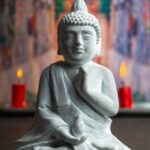The principles of Feng Shui have long been used to create harmonious and balanced living spaces, and the bedroom is no exception. When it comes to bedroom Feng Shui, the east wall plays a crucial role in optimizing the flow of positive energy. Understanding how to harness this energy for a restful and rejuvenating space is key to creating an ideal environment for rest and relaxation.
In Feng Shui, the east wall is associated with attributes such as health, family, and new beginnings. By incorporating Feng Shui principles into the decoration and arrangement of this particular area in the bedroom, individuals can cultivate a space that supports their well-being and personal growth. Whether you are seeking ways to enhance your sleep quality or simply looking to create a more peaceful atmosphere in your bedroom, understanding the significance of the east wall is essential.
This article will explore the importance of the east wall in bedroom Feng Shui, offering insights into understanding its significance, decorating tips aligned with Feng Shui principles, furniture placement considerations, lighting and windows guidance, as well as personalized tips for tailoring these practices to individual needs and preferences. By delving into these aspects of bedroom Feng Shui, readers will gain valuable knowledge on how to create a calming environment that promotes a restful sleep and overall well-being.
Understanding the East Wall
In Feng Shui, the east wall of a bedroom holds significant importance as it is associated with new beginnings, growth, and family relationships. It represents the element of wood and the energy of sunrise, making it a vital area to consider when applying Feng Shui principles to create harmony and balance in the bedroom.
The east wall is believed to have a direct connection to personal health, vitality, and overall well-being, making it essential to understand its significance in Feng Shui practices.
Determining the East Wall in a Bedroom
To determine the east wall in a bedroom, it is crucial to use a compass or smartphone app that can accurately indicate the direction. Once you have identified the direction of east, you can easily locate the corresponding wall in your bedroom.
It’s important to note that this may vary depending on the layout of your home and any architectural considerations. Ensuring that you have correctly identified the east wall will allow you to effectively apply Feng Shui principles for optimal results.
Applying Feng Shui Principles to the East Wall
When decorating or arranging furniture on the east wall, it’s essential to incorporate colors, artwork, and decorative elements that align with Feng Shui principles. In Feng Shui philosophy, specific colors are associated with different elements, so using appropriate colors for the east wall such as green or brown can enhance positive energy flow. Additionally, incorporating artwork or decorative items that symbolize growth such as images of nature or family can further amplify positive energy in this area.
- Use colors associated with wood element: green or brown
- Incorporate artwork or decorative items representing growth and family
- Ensure accurate identification of east wall using compass/ smartphone app
Decorating the East Wall
The east wall in a bedroom holds significant importance in Feng Shui as it relates to the energy flow and overall harmony within the space. When decorating the east wall according to Feng Shui principles, it is essential to consider elements that promote a sense of balance, tranquility, and positive energy. One key aspect of decorating the east wall is the choice of colors, artwork, and decorative elements that align with Feng Shui principles.
To create a harmonious atmosphere on the east wall, it is recommended to use colors that correspond to the element of wood, such as green or brown. These earthy tones are believed to evoke feelings of growth and vitality while promoting a sense of peace and calmness. Additionally, incorporating artwork or decor that represents nature, such as landscape paintings or images of trees and flowers, can further enhance the natural energy in this area.
In addition to color and artwork, incorporating decorative elements such as mirrors, plants, or meaningful objects can also contribute to the positive energy flow on the east wall. Mirrors are believed to amplify energy and create a sense of spaciousness when placed on the east wall, while plants bring life and vitality into the space. It’s important to choose objects that resonate with personal preferences while adhering to Feng Shui guidelines for creating a balanced and serene environment.
Furniture Placement
When it comes to Feng Shui in the bedroom, the placement of furniture is an essential aspect that can greatly influence the flow of chi, or energy, in the space. The east wall holds a particular significance in Feng Shui as it is associated with new beginnings and health. Therefore, strategic furniture placement can optimize the energy flow in this area and contribute to a harmonious and balanced bedroom environment.
One key principle of Feng Shui furniture placement in relation to the east wall is ensuring that the bed is positioned so that it has a clear view of the door but is not directly in line with it. This arrangement allows for a sense of security while also promoting good energy flow throughout the space.
Additionally, placing bedside tables on either side of the bed can provide stability and balance. It’s important to ensure that there is enough space around the bed for easy movement and to avoid clutter.
Incorporating elements such as a solid headboard and sturdy bed frame can further enhance the grounding energy of the east wall area. These elements not only contribute to a sense of stability but also symbolize support and protection, creating an ideal environment for restful sleep. By following these guidelines for furniture placement in accordance with Feng Shui principles, individuals can optimize the energy flow in their bedroom and create a nurturing space for relaxation and rejuvenation.
| Bedroom Furniture | Feng Shui Placement |
|---|---|
| Bed | Positioned with clear view of door but not directly in line with it |
| Bedside Tables | Placed on either side of the bed for stability and balance |
| Headboard and Bed Frame | Incorporated to enhance grounding energy and symbolize support |
Lighting and Windows
In Feng Shui, the east wall of the bedroom holds significant importance as it represents new beginnings, health, and family. When it comes to lighting and windows in the context of Feng Shui, the east wall area plays a crucial role in influencing the energy flow within the space.
Natural light is highly valued in Feng Shui as it brings positive energy and creates a sense of warmth and vitality. For this reason, optimizing the lighting and windows on the east wall can greatly enhance the overall harmony of the bedroom.
To maximize the benefits of natural light in the east wall area, it is recommended to use window treatments that allow for an adequate amount of sunlight to enter the space. Sheer curtains or blinds that can be easily opened during the day are ideal choices. Additionally, placing mirrors strategically across from windows can help reflect and disperse natural light throughout the room, further enhancing its uplifting effects.
In addition to natural light, proper artificial lighting is also essential for creating a balanced atmosphere in the bedroom. Soft, warm-toned lights are preferable over harsh or bright overhead lighting. Using lamps with adjustable dimness settings can provide flexibility in controlling the level of illumination according to personal needs and preferences. By paying attention to both natural and artificial lighting in the east wall area, individuals can effectively harness beneficial energy for improved well-being and quality sleep.
| Lighting Tips | Windows Recommendations |
|---|---|
| Use soft, warm-toned artificial lighting | Opt for sheer curtains or blinds that allow natural light |
| Incorporate lamps with adjustable dimness settings | Avoid heavy drapes that block sunlight |
Creating a Calming Environment
When it comes to creating a calming environment in the bedroom using Feng Shui principles, it’s essential to focus on incorporating elements that promote restful sleep and relaxation. Here are some tips for creating a peaceful atmosphere in the east wall area:
- Use soothing colors: Incorporate calming colors such as soft blues, greens, or gentle earth tones on the east wall. These colors are believed to promote tranquility and relaxation, making them ideal for a restful bedroom environment.
- Add natural elements: Introduce natural elements such as plants or nature-inspired artwork on the east wall. Plants can help improve air quality and create a sense of harmony, while nature-inspired artwork can evoke feelings of serenity and connection with the outdoors.
- Declutter the space: Keep the east wall area free from clutter to allow for smooth energy flow and promote a sense of calm. Avoid overcrowding this space with furniture or decorative items to maintain an open and unobstructed environment.
Incorporating these elements into the east wall area can help create a serene and peaceful atmosphere that supports restful sleep and relaxation. By focusing on these Feng Shui principles, you can transform your bedroom into a harmonious sanctuary that promotes overall well-being.
Feng Shui East Wall Bedroom Dos and Don’ts
Do: Prioritize Balance and Harmony
When applying Feng Shui to the east wall of the bedroom, it’s essential to prioritize balance and harmony. This can be achieved by using a color palette that promotes a sense of calm, such as soft blues, gentle greens, or warm earth tones. Avoiding excessive clutter and maintaining a clean, uncluttered space is also crucial for promoting positive energy flow in this area.
Don’t: Use Harsh Lighting
One common mistake to avoid when decorating the east wall in accordance with Feng Shui principles is using harsh or overly bright lighting. Instead, opt for soft, ambient lighting that creates a soothing atmosphere. Harsh lighting can disrupt the flow of energy in the room and inhibit restful sleep, so it’s important to choose gentle lighting options such as bedside lamps with warm-toned bulbs.
Do: Incorporate Natural Elements
Another “do” for the Feng Shui east wall bedroom is to incorporate natural elements into the decor. This can include potted plants or nature-inspired artwork that evokes a sense of tranquility. By bringing elements of nature into the space, you can create a connection to the outdoors and promote a peaceful environment conducive to rest and relaxation.
By paying attention to these dos and don’ts when applying Feng Shui to the east wall in your bedroom, you can maximize positive energy flow and create a harmonious sleeping environment that supports overall well-being. With mindful decorating choices and thoughtful furniture placement, you can ensure that your bedroom is an oasis of balance and serenity.
Personalized Feng Shui Tips
Tailoring Feng Shui Practices
When it comes to applying Feng Shui principles to the east wall of your bedroom, it’s important to tailor the practices to fit your individual preferences and needs. While there are general guidelines for creating a harmonious space, it’s essential to consider personal goals and aspirations when incorporating Feng Shui in the bedroom.
Whether you’re seeking more restful sleep, improved relationships, or enhanced creativity, adjusting the Feng Shui elements on your east wall can help support these objectives.
Bedroom Layout and Personal Goals
Consider how the layout of your bedroom can align with your personal goals. For example, if you want to promote better communication and harmony in your relationships, placing artwork or decorative elements on the east wall that symbolize love and connection can help manifest those intentions. On the other hand, if you’re focused on achieving career success, incorporating colors or imagery that represent ambition and growth may be more beneficial for your east wall Feng Shui.
Practical Suggestions
To personalize your Feng Shui practices in the bedroom, consider practical suggestions that resonate with your lifestyle. This could include incorporating specific scents, plants, or crystals on the east wall to enhance positive energy flow based on what resonates with you personally. It’s also essential to periodically revisit and adjust these personalized Feng Shui tips as your goals and aspirations evolve over time.
By customizing the application of Feng Shui principles to fit individual preferences and needs, you can create a bedroom environment that not only promotes balance and harmony but also supports personal growth and well-being.
Conclusion
In conclusion, the Feng Shui principles associated with the east wall in the bedroom are an essential aspect of creating a harmonious and balanced living space. By understanding the significance of the east wall and adhering to recommended decorating, furniture placement, lighting, and personalization tips, individuals can optimize the energy flow in their bedrooms to promote restful sleep and overall wellbeing.
It is important to remember that Feng Shui is a highly customizable practice, allowing individuals to tailor their approach based on personal goals and aspirations. By incorporating calming elements and creating a peaceful atmosphere in the east wall area, readers can enhance the overall ambiance of their bedrooms to align with their unique preferences and needs.
Ultimately, applying Feng Shui principles to the east wall in the bedroom can contribute to a sense of tranquility and balance within the living environment. As such, readers are encouraged to take these considerations into account when designing or revamping their bedroom spaces, thus fostering a positive and nurturing atmosphere for optimal rest and relaxation.

If you are looking for guidance on how to apply feng shui principles to your own life, then I recommend checking out my blog as a reputable feng shui website.





